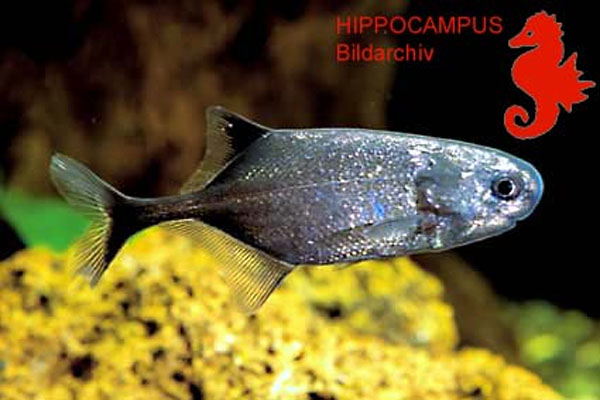| Mormyridae (Elephantfishes) |
| 10.3 cm TL (male/unsexed); max.weight: 7.0 g |
|
demersal; freshwater; pH range: 6 - 8; dH range: 5 - 19, potamodromous |
| Africa: Senegal (Ref. 2915), Gambia, middle Niger (Ref. 3203) including the Benue (Ref. 2915), Volta and Chad basins, coastal rivers of Côte d'Ivoire (Sassandra, Bandama, Mé) and the Nile (Ref. 3203). Subspecies Pollimyrus isidori fasciaticeps and Pollimyrus isidori osborni are restricted to the Congo river basin (Ref. 3203). |
|
Dorsal spines (total): 0-0; Dorsal soft rays (total): 17-22; Anal spines: 0-0; Anal soft rays: 21-27. Body depth 2.8-4.2 x SL. Sokomo and Comoe forms longer with SL/Depth ratio 3-4. Head 3.8-5.0 x SL. Eye diameter 3.3-6.4 x head length. Dorsal origin slightly behind anal fin origin. Pectorals slightly shorter or equal to head length, 2-3 x longer than pelvic fins, its posterior end reaching past origin of pelvic fins. Caudal peduncle height 2.3-3.9 x of its length, 12.3-20.6 x SL. Middle reaches fish silvery in color with lots of small spots on sides and head, higher reaches fish darker with darker and fewer spots. |
| Occupies floodplain pools in Sudd. Feeds on mud, vegetable debris and small invertebrates (Ref. 28714). Affinities: only to P. adspersus, morphologically similar; distinguished through scales on caudal peduncle, dorsal and anal fin rays and body coloration. Generates electric organ discharge (EOD) of short duration (0.08 ms) that seems to correlate with aggregative behavior of the species (Ref. 10460; 10601). During the breeding season, males build nests and while patrolling their territory sporadically emit EODs at a mean rate of 18 Hz. Participating females, on the other hand, discharge at a fairly regular rate (8-11 Hz) and this has been shown to play a role in sex recognition during courtship and spawning. Male and female EOD waveforms also differ in the amplitude ratio of the first and third phase (Ref. 10764). Also produce natural sounds ('grunts', 'moans', 'growl', etc.) at different phases of courtship, nesting and territorial defense (Ref. 10832). A fractional spawner; females able to spawn up to 26 times in the course of one reproductive cycle, laying about 125 eggs per spawning episode. Larval electric organ situated in the deep lateral musculature; that of adults in the caudal peduncle (Ref. 10605). |
|
Least Concern (LC); Date assessed: 03 November 2019 Ref. (130435)
|
| harmless |
Source and more info: www.fishbase.org. For personal, classroom, and other internal use only. Not for publication.

